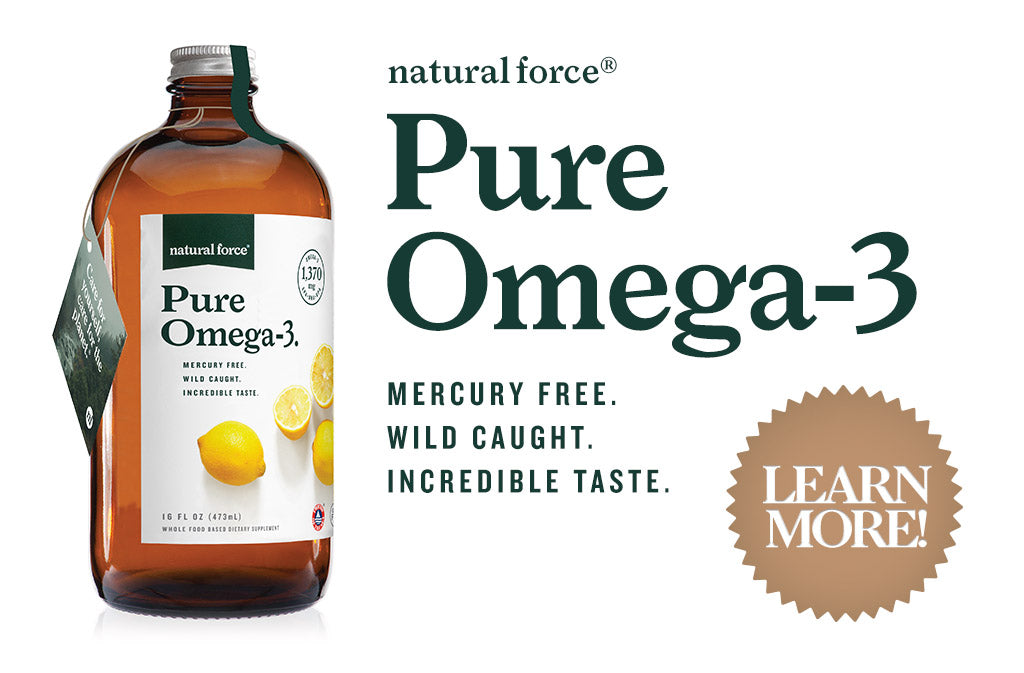Is My Fish Oil Rancid? What to Look For & How to Prevent It
Fish oil is highly effective at reducing inflammation, boosting memory, and improving cardiovascular health, but unfortunately, fish oil supplements can easily become rancid. This sensitive oil is prone to oxidation when exposed to light, heat, or oxygen, and once oxidation occurs, fish oil can cause more harm than benefit. You can spot the signs of rancidity by looking for a strong fishy smell and aftertaste, or a cloudy and splotchy appearance. To ensure that your fish oil is fresh, choose a product packaged in UV-blocking glass and that is tested for oxidation.
In this article, you will learn:
- Does Fish Oil Go Rancid?
- How Do You Know If Fish Oil Is Rancid?
- What Should I Look For When Buying Fish Oil?
- What's the Best Fish Oil?
Does Fish Oil Go Rancid?
Unfortunately, yes, fish oil is very susceptible to going rancid. In fact, a recent report showed that nearly 40% of fish oil brands on the market exceed the safe limits of oxidation. That’s almost one out of every two fish oil products!
Here’s why fish oil goes rancid so quickly: Fish oil is naturally abundant in EPA and DHA omega-3, which are polyunsaturated fats. These polyunsaturated fats have multiple double bonds between their carbon atoms, which are prone to oxidation when they’re exposed to heat, light, or oxygen. Compared to fresh fish oil, the altered chemical structures of these oxidized molecules can cause harm to your body.
Rancid fish oil is a huge cause for concern due to its negative health consequences. Though fresh fish oil has many benefits like reducing inflammation, boosting memory, and improving cardiovascular health, when fish oil goes bad, it doesn’t have a neutral effect, it actually does harm.
One study showed that rancid fish oil can increase “bad” cholesterol (LDL) levels. The month-long study featured two groups of women; one group was given highly-oxidized fish oil, while the other group consumed a fresh fish oil. By the end of the month, the women who took the extremely-oxidized oil had higher levels of LDL cholesterol, while the group with the fresh, unoxidized oil had lowered their levels of LDL.
Several animal studies have also shown that oxidized fish oil can have severe health consequences, causing organ damage, inflammation, and insulin insensitivity that led to weight gain.
How Do You Know If Fish Oil Is Rancid?
Here are some tell-tale signs to know when it’s time to toss out your fish oil:
The Expiration Date Has Passed
No matter how great a fish oil's packaging may be at preserving freshness, the expiration date is there for a reason. Even if you’ve never opened the bottle, you’re charting into risky territory consuming a fish oil after the expiration date has passed.
Your Fish Oil Has a Strong Fishy Smell
Despite popular belief, fish oil is not supposed to taste fishy! Once oxidation happens, you may notice a fishy smell which is a sign of spoiling. The moral of the story is, if your oil starts to smell like Seattle’s famous Pike Place Fish Market, take it as a cautionary sign to avoid consumption.
Your Fish Oil has an Unpleasant After-Taste
Research on oxidized fish oils shows that one of the most common signs of rancidity is a fishy aftertaste and fish-flavored burps (unpleasant, we know). Rancid fish oil breaks down quickly, increasing acidity in the stomach, commonly leading to those fishy-tasting burps.
Its Been Under the Light or High Heat
Fish oils are highly susceptible to warm temperatures and light. One day of being in the sun or stored in a hot car is all it takes for your fish oil to begin oxidizing.
If your fish oil has been exposed to any of these conditions, it’s time to ditch it and start with a fresh bottle.
What Should I Look For When Buying Fish Oil?
Because fish oil is so susceptible to rancidity, creating a high-quality fish oil is difficult, and it’s important to know that not all brands are created equal.
With that said, here’s what to look for to ensure you find a fish oil brand that stays fresh and delivers its health-promoting benefits to you for as long as possible:
It’s Packaged in a Dark Glass Bottle
Since oxidation occurs when fish oil’s polyunsaturated fat molecules are exposed to heat, light, or oxygen, proper packaging is incredibly important.
Storing fish oil in a dark glass bottle, for example, is a simple, natural method to retain freshness. Many fish oil products have a shelf life of up to 24 months with proper storage and packaging.
It’s Lab-Tested for Freshness
Ensure your fish oil is fresh by purchasing a brand that does third-party lab testing and shares the results. These tests report the levels of primary and secondary oxidation in each bottle, and whether or not they’re in the safe ranges, so you can be confident you’re getting the best product.
One common, but harmful compound that results from oxidation is called hydroperoxide. If a fish oil has a high peroxide value (PV), it’s known to counter the health benefits of omega-3 by causing the production of hazardous secondary oxidative compounds like anisidine.
According to the Global Organization for Omega-3, an unsafe peroxide value starts at 5.0 milliequivalent/kg, although most brands have levels of 8.0 and over.
Disturbingly, a 2015 study found that 27% of American fish oils exceeded more than two times the recommended amount of peroxides. Meanwhile, in countries like South Africa and New Zealand, more than 80% of all the fish oils tested for peroxide levels that were higher than recommended safety levels.
For the purest fish oil brands, check for a PV between 2 and 3 in their testing results.
It Contains Natural Antioxidants
Look for fish oil containing natural antioxidants (vs. chemical preservatives) because those are essential for extending a fish oil's shelf life and preventing rancidity.
Natural antioxidants like rosemary extract and/or mixed tocopherols (vitamin E) are particularly effective at slowing the process of oxidation, making it easy to preserve fish oil’s freshness without the need for any potentially-harmful additives.
What's the Best Fish Oil?
The best fish oil is one that's made with natural, quality ingredients and stays fresh so you can reap all its health-promoting benefits. Not only should it contain natural antioxidants such as rosemary extract and mixed tocopherols, but it should also be packed in a dark glass, UV-blocking bottle that's BPA-free and third-party tested to ensure a safe peroxide value (aka the absence of rancidity).
We're proud to say that Natural Force Pure Omega 3 Fish Oil checks all of these boxes and then some.
In addition to these essentials, our ultra-fresh fish oil is meticulously crafted to deliver maximum health benefits to you, while minimizing its impact on the planet.
Pure Omega 3 is sourced from menhaden fish, which are not only sustainable and toxin-free, but they're also one of the world’s most abundant sources of DPA, a powerful anti-inflammatory omega-3 fatty acid that's absorbed 22% more effectively than it's common counterpart, EPA.
We're so confident in the quality of Pure Omega 3 that we make our third-party lab test results public. Our fish oil has an incredibly low PV of just 0.3, making it one of the cleanest, freshest brands available!
Learn more!
UP NEXT: What is DPA Fish Oil? The New Omega-3 You Should Know About
(Want articles like this via email? Here's the sign up!)

